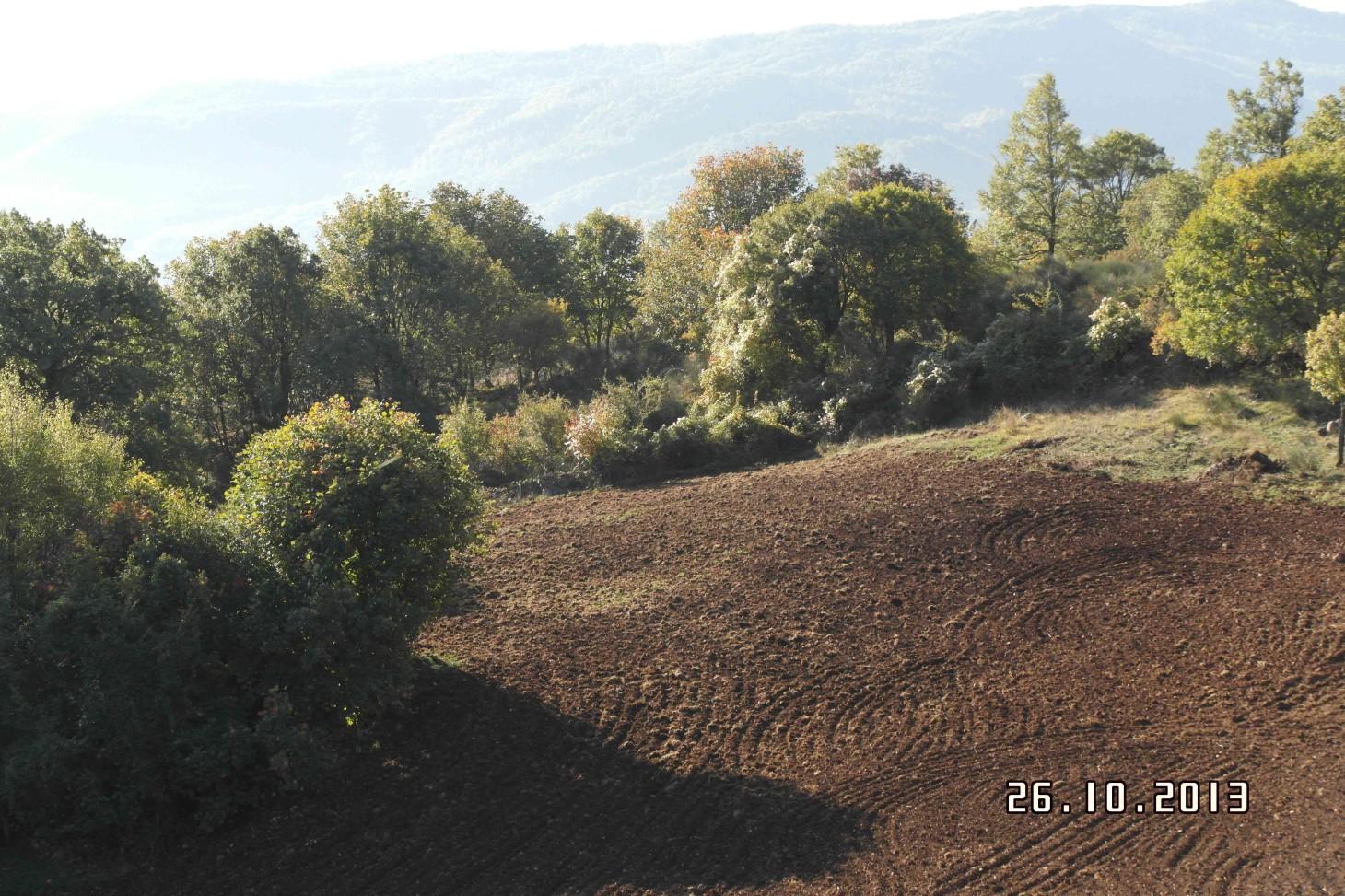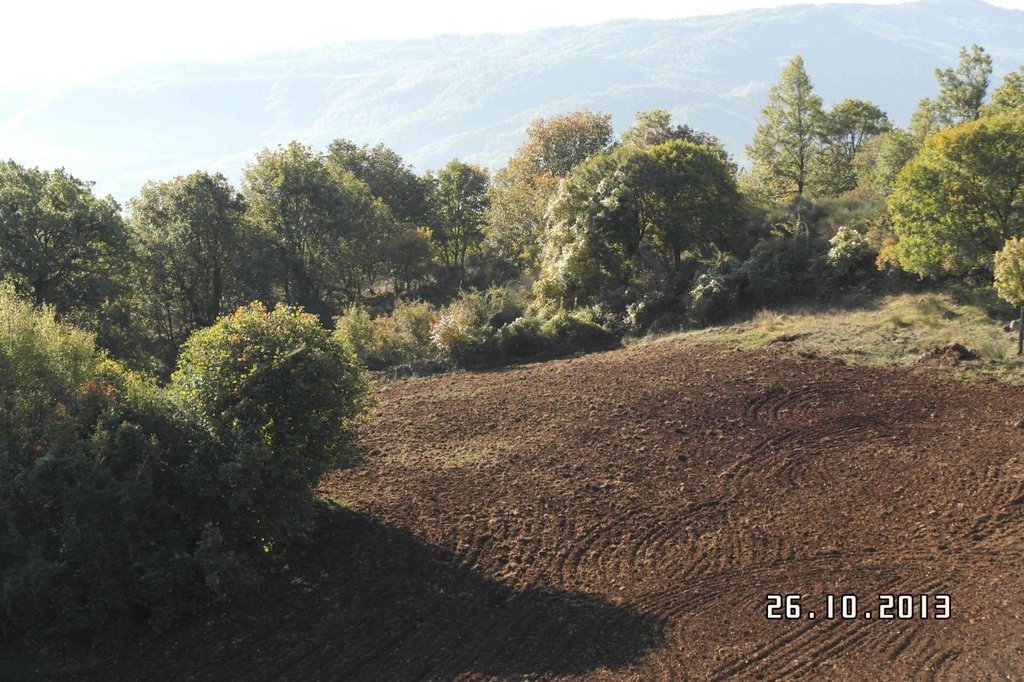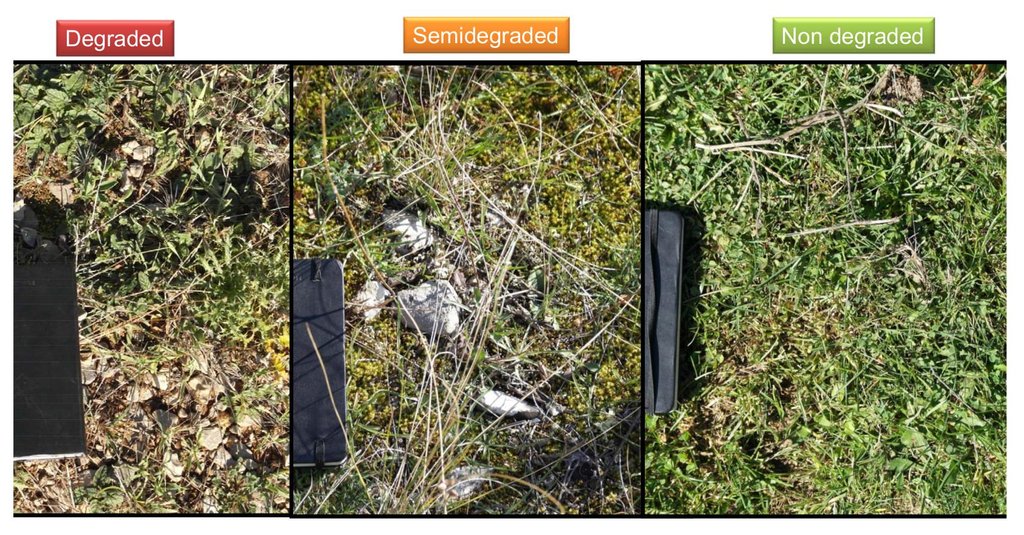Ploughing and seeding of fodder species to recover degraded grazing areas [意大利]
- 创建:
- 更新:
- 编制者: Velia De Paola
- 编辑者: –
- 审查者: Fabian Ottiger, Alexandra Gavilano
technologies_1210 - 意大利
查看章节
全部展开 全部收起1. 一般信息
1.2 参与该技术评估和文件编制的资源人员和机构的联系方式
SLM专业人员:
Quaranta Giovanni
University of Basilicata
意大利
有助于对技术进行记录/评估的项目名称(如相关)
Catastrophic shifts in drylands (EU-CASCADE)有助于对技术进行记录/评估的机构名称(如相关)
University of Basilicata - 意大利1.3 关于使用通过WOCAT记录的数据的条件
编制者和关键资源人员接受有关使用通过WOCAT记录数据的条件。:
是
2. SLM技术的说明
2.1 技术简介
技术定义:
Ploughing and seeding of fodder species to recover old degraded grazing areas and maintain valuable pastures against shrub encroachment and decrease of palatable species
2.2 技术的详细说明
说明:
The technology consists of seeding pastureland with high palatable species whenever they are purely represented. In order to ensure a quality grass cover for grazing areas, pastures are ploughed (removing non-palatable shrubs) and planted with a variety of grains: i.e. oats, barley, alfalfa. This operation is periodically repeated (every tree-four years) according to the state of the grasses.
Purpose of the Technology: Regeneration of degraded pastures
Natural / human environment: The technique is an agronomic measure which is applied to degraded pastures (often modest areas of pasture land closest to farm sheds and stables).
As to the context of production, it is characterised by a medium level of mechanisation (only the most demanding operations are carried out using mechanical means), the production system is essentially mixed, a small part is destined for personal consumption whilst the bulk of production is destined for local markets. The property is predominantly privately owned but also includes some public land, especially in the case of pasture land. Most farms in the area are livestock farms whilst the agricultural component is destined exclusively for private consumption.
2.3 技术照片
2.5 已应用该技术的、本评估所涵盖的国家/地区/地点
国家:
意大利
区域/州/省:
Basilicata
有关地点的进一步说明:
Castelsaraceno
具体说明该技术的分布:
- 均匀地分布在一个区域
如果不知道精确的区域,请注明大致覆盖的区域:
- 0.1-1 平方千米
2.6 实施日期
如果不知道确切的年份,请说明大概的日期:
- 50多年前(传统)
2.7 技术介绍
详细说明该技术是如何引入的:
- 作为传统系统的一部分(> 50 年)
注释(项目类型等):
Ploughing and seeding has been the main traditional land use in the area
3. SLM技术的分类
3.1 该技术的主要目的
- 减少、预防、恢复土地退化
- 保护生态系统
- 保持/提高生物多样性
3.2 应用该技术的当前土地利用类型
同一土地单元内混合使用的土地::
是
具体说明混合土地使用(作物/放牧/树木):
- 农牧业(包括农牧结合)

农田
- 一年一作
年作 - 具体指明作物:
- 谷类 - 大麦
- 谷类 - 燕麦
- 饲料作物 - 苜蓿
- wheat
每年的生长季节数:
- 1
具体说明:
Longest growing period in days: 120 Longest growing period from month to month: March to august
采用间作制度了吗?:
是

牧场
粗放式放牧:
- 半游牧畜牧业
- 经营牧场
动物类型:
- 山羊
- 绵羊
- cows
注释:
In order to ensure a quality grass cover for grazing areas, pastures are ploughed (removing non-palatable shrubs) and planted with a variety of grains: i.e. oats, barley, alfalfa
Major land use problems (compiler’s opinion): Change of vegetation in pastures: encroachment of unpalatable species
Major land use problems (land users’ perception): The problem is degraded pastures (presence of non-palatable shrubs).
Semi-nomadism / pastoralism: Shepherds use the area for summer grazing and move downhill in winter
Mixed: (eg agro-pastoralism, silvo-pastoralism): A reduced number of farmers cultivate their field for fodder and pastures
Grazingland comments: Sheep and goats are the most valuable livestock
Type of grazing system comments: Sheep and goats are the most valuable livestock
Livestock density: > 100 LU /km2
3.4 供水
该技术所应用土地的供水:
- 雨养
注释:
Water supply: Also mixed rainfed - irrigated
3.5 该技术所属的SLM组
- 改良的地面/植被覆盖
- 最小的土壤扰动
3.6 包含该技术的可持续土地管理措施

农艺措施
- A1:植被和土壤覆盖层
注释:
Main measures: agronomic measures
Type of agronomic measures: mixed cropping / intercropping, minimum tillage
3.7 该技术强调的主要土地退化类型

生物性退化
- Bs:质量和物种组成/多样性的下降
注释:
Main type of degradation addressed: Bs: quality and species composition /diversity decline
Main causes of degradation: other human induced causes (specify) (Undergrazing)
Secondary causes of degradation: poverty / wealth
3.8 防止、减少或恢复土地退化
具体数量名该技术与土地退化有关的目标:
- 修复/恢复严重退化的土地
4. 技术规范、实施活动、投入和成本
4.1 该技术的技术图纸
技术规范(与技术图纸相关):
Technical knowledge required for land users: moderate
Main technical functions: increase of biomass (quantity), promotion of vegetation species and varieties (quality, eg palatable fodder)
Secondary technical functions: increase of infiltration, increase / maintain water stored in soil
Mixed cropping / intercropping
Material/ species: oats, barley, alfalfa, wheat
4.2 有关投入和成本计算的一般信息
其它/国家货币(具体说明):
euro
如相关,注明美元与当地货币的汇率(例如1美元=79.9巴西雷亚尔):1美元=:
0.74
4.3 技术建立活动
| 活动 | 时间(季度) | |
|---|---|---|
| 1. | Ploughing with machinery and add fertilizer if needed | November/ from each year to every 5-8 years |
| 2. | Seeding | November/ from each year to every 5-8 years |
4.4 技术建立所需要的费用和投入
| 对投入进行具体说明 | 单位 | 数量 | 单位成本 | 每项投入的总成本 | 土地使用者承担的成本% | |
|---|---|---|---|---|---|---|
| 劳动力 | Seeding | ha | 1.0 | 54.05 | 54.05 | 100.0 |
| 设备 | Ploughing with machinery and add fertilizer if needed | ha | 1.0 | 270.27 | 270.27 | 100.0 |
| 植物材料 | Seeds | ha | 1.0 | 202.7 | 202.7 | 100.0 |
| 技术建立所需总成本 | 527.02 | |||||
| 技术建立总成本,美元 | 712.19 | |||||
注释:
Costs occur again every 5-8 years
4.5 维护/经常性活动
| 活动 | 时间/频率 | |
|---|---|---|
| 1. | Ploughing with machinery and add fertilizer if needed | November/ from each year to every 5-8 years |
| 2. | Seeding | November/ from each year to every 5-8 years |
4.6 维护/经常性活动所需要的费用和投入(每年)
注释:
Machinery/ tools: tractor with arrow
The above costs have been calculated according to the average of small farm’s records.
4.7 影响成本的最重要因素
描述影响成本的最决定性因素:
The most determinate factor affecting costs of the technique is the availability of equipment for spreading. The largest farms buy the equipment spending from 35,000 to 40,000 euro depending on the machines’ working capacities. The smaller farms (which represent the vast majority) rent this equipment at a cost of around €50 an hour.
5. 自然和人文环境
5.1 气候
年降雨量
- < 250毫米
- 251-500毫米
- 501-750毫米
- 751-1,000毫米
- 1,001-1,500毫米
- 1,501-2,000毫米
- 2,001-3,000毫米
- 3,001-4,000毫米
- > 4,000毫米
指定年平均降雨量(若已知),单位为mm:
1519.00
有关降雨的规范/注释:
68% in winter and 15% in summer
农业气候带
- 半湿润
Thermal climate class: temperate
5.2 地形
平均坡度:
- 水平(0-2%)
- 缓降(3-5%)
- 平缓(6-10%)
- 滚坡(11-15%)
- 崎岖(16-30%)
- 陡峭(31-60%)
- 非常陡峭(>60%)
地形:
- 高原/平原
- 山脊
- 山坡
- 山地斜坡
- 麓坡
- 谷底
垂直分布带:
- 0-100 m a.s.l.
- 101-500 m a.s.l.
- 501-1,000 m a.s.l.
- 1,001-1,500 m a.s.l.
- 1,501-2,000 m a.s.l.
- 2,001-2,500 m a.s.l.
- 2,501-3,000 m a.s.l.
- 3,001-4,000 m a.s.l.
- > 4,000 m a.s.l.
5.3 土壤
平均土层深度:
- 非常浅(0-20厘米)
- 浅(21-50厘米)
- 中等深度(51-80厘米)
- 深(81-120厘米)
- 非常深(> 120厘米)
土壤质地(表土):
- 细粒/重质(粘土)
表土有机质:
- 中(1-3%)
如有可能,附上完整的土壤描述或具体说明可用的信息,例如土壤类型、土壤酸碱度、阳离子交换能力、氮、盐度等。:
Soil fertility is medium-low
Soil drainage/infiltration is good
Soil water storage capacity is medium
5.4 水资源可用性和质量
地下水位表:
5-50米
地表水的可用性:
中等
水质(未处理):
良好饮用水
关于水质和水量的注释和进一步规范:
Availability of surface water: Medium (minimum during month of September and October)
5.5 生物多样性
物种多样性:
- 中等
5.6 应用该技术的土地使用者的特征
生产系统的市场定位:
- 商业/市场
非农收入:
- 收入的10-50%
相对财富水平:
- 平均水平
个人或集体:
- 个人/家庭
性别:
- 男人
说明土地使用者的其他有关特征:
Land users applying the Technology are mainly common / average land users
Difference in the involvement of women and men: Active farmers are present only males; women are not actively involved in land management
Population density: 10-50 persons/km2
Annual population growth: negative; 2%
90% of the land users are average wealthy.
10% of the land users are poor.
Off-farm income specification: Most of the off farm income derives from public sector, i.e. Municipality, Mountain Community, Region and other public bodies. Very few farmer members run local shops or handcraft.
5.7 应用该技术的土地使用者使用的平均土地面积
- < 0.5 公顷
- 0.5-1 公顷
- 1-2 公顷
- 2-5公顷
- 5-15公顷
- 15-50公顷
- 50-100公顷
- 100-500公顷
- 500-1,000公顷
- 1,000-10,000公顷
- > 10,000公顷
这被认为是小规模、中规模还是大规模的(参照当地实际情况)?:
- 小规模的
注释:
Considering communal land used by farmers
5.8 土地所有权、土地使用权和水使用权
土地所有权:
- 社区/村庄
- 个人,有命名
土地使用权:
- 社区(有组织)
- 个人
5.9 进入服务和基础设施的通道
健康:
- 贫瘠
- 适度的
- 好
教育:
- 贫瘠
- 适度的
- 好
技术援助:
- 贫瘠
- 适度的
- 好
就业(例如非农):
- 贫瘠
- 适度的
- 好
市场:
- 贫瘠
- 适度的
- 好
能源:
- 贫瘠
- 适度的
- 好
道路和交通:
- 贫瘠
- 适度的
- 好
饮用水和卫生设施:
- 贫瘠
- 适度的
- 好
金融服务:
- 贫瘠
- 适度的
- 好
6. 影响和结论性说明
6.1 该技术的现场影响
社会经济效应
生产
饲料生产
SLM之前的数量:
4t/ha
SLM之后的数量:
8t/ha
饲料质量
注释/具体说明:
Increase of the ratio palatable/total species
生产故障风险
收入和成本
农业投入费用
农业收入
社会文化影响
Improved livelihoods and human well-being
生态影响
水循环/径流
地表径流
多余水的排放
地下水位/含水层
土壤
土壤覆盖层
土壤结壳/密封
土壤压实
养分循环/补给
土壤有机物/地下C
生物多样性:植被、动物
生物量/地上C
植物多样性
有益物种
害虫/疾病控制
减少气候和灾害风险
碳和温室气体的排放
6.2 该技术的场外影响已经显现
缓冲/过滤能力
6.3 技术对渐变气候以及与气候相关的极端情况/灾害的暴露和敏感性(土地使用者认为的极端情况/灾害)
渐变气候
渐变气候
| 季节 | 增加或减少 | 该技术是如何应对的? | |
|---|---|---|---|
| 年温度 | 增加 | 好 |
气候有关的极端情况(灾害)
气象灾害
| 该技术是如何应对的? | |
|---|---|
| 局地暴雨 | 好 |
| 局地风暴 | 好 |
气候灾害
| 该技术是如何应对的? | |
|---|---|
| 干旱 | 好 |
水文灾害
| 该技术是如何应对的? | |
|---|---|
| 比较和缓的(河道)洪水 | 好 |
其他气候相关的后果
其他气候相关的后果
| 该技术是如何应对的? | |
|---|---|
| 缩短生长期 | 好 |
6.4 成本效益分析
技术收益与技术建立成本相比如何(从土地使用者的角度看)?
短期回报:
轻度消极
长期回报:
稍微积极
技术收益与技术维护成本/经常性成本相比如何(从土地使用者的角度看)?
短期回报:
轻度消极
长期回报:
轻度消极
6.5 技术采用
在所有采用这项技术的人当中,有多少人是自发的,即未获得任何物质奖励/付款?:
- 0-10%
注释:
90% of land user families have adopted the Technology with external material support
Comments on acceptance with external material support: The activities were initially supported by a regional program with a subside equal to 50% of the total cost. However the technology proved not very efficient from the economic point of view, hence the subsidies where suspended.
10% of land user families have adopted the Technology without any external material support
There is no trend towards spontaneous adoption of the Technology
6.7 该技术的优点/长处/机会
| 土地使用者眼中的长处/优势/机会 |
|---|
|
The technology can improve very degraded pastureland but is not very useful when the pasture is only partly degraded How can they be sustained / enhanced? In order to increase the technology supports to machinery use should be provided, since they are the main relevant cost/barrier to adopt the technology. |
| 编制者或其他关键资源人员认为的长处/优势/机会 |
|---|
|
The technology can improve productivity and help restore the most valuable pastures, especially those situated near the animal housing structures How can they be sustained / enhanced? Subsidies where available in the past but didn’t prove effective or beneficial. |
6.8 技术的弱点/缺点/风险及其克服方法
| 土地使用者认为的弱点/缺点/风险 | 如何克服它们? |
|---|---|
| High cost of machinery/equipment and their difficult use in tough environmental conditions (stony lands and steep slopes). |
| 编制者或其他关键资源人员认为的弱点/缺点/风险 | 如何克服它们? |
|---|---|
| Removing soil surfaces in order to seed the lands can create condition for soil degradation if not performed adequately | Increasing farmers awareness and skills for good agricultural practices |
7. 参考和链接
7.1 信息的方法/来源
链接和模块
全部展开 全部收起链接
无链接
模块
无模块




